Dreaming of a home that turns heads? Small white houses with black trim offer that perfect balance. This classic color combination has stood the test of time. It creates stunning definition against any landscape.
Your modest-sized home will appear more distinctive. The architectural details will pop with visual interest. Whether you’re renovating a cozy cottage or planning a tiny house, these colors work magic. White and black create a versatile foundation. They complement any architectural style. They enhance curb appeal instantly.
Ready to transform your small space? Let’s explore 12 inspiring ideas. Sometimes the most impactful statements come in smaller packages.
12 Design Ideas for Small White Houses with Black Trim
1. Black Window Casings
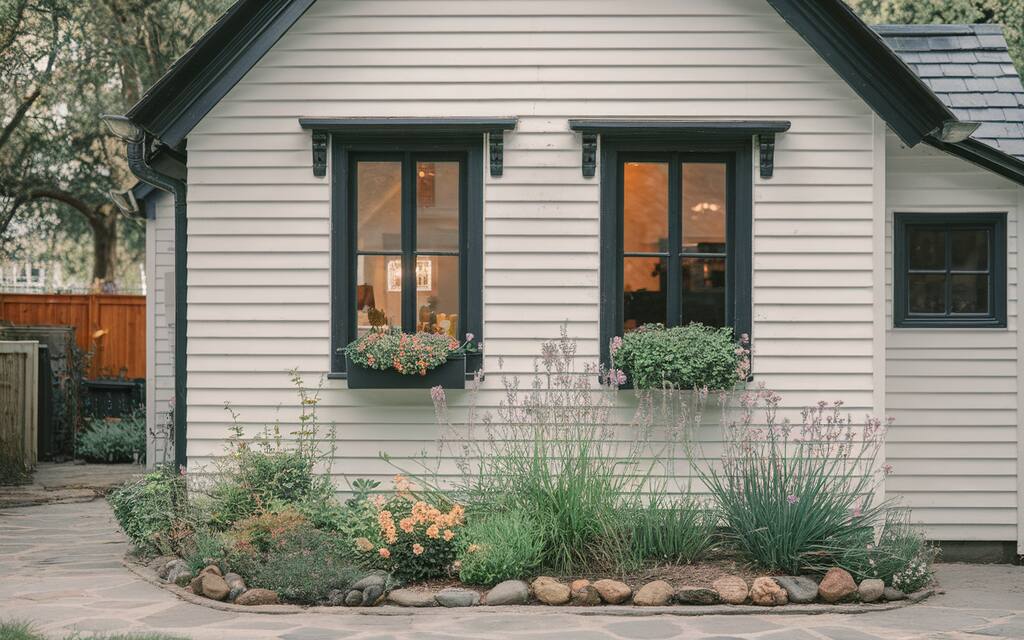
Black window casings transform white houses into showstoppers. They outline your views like perfect frames. Your windows gain instant prominence. Even basic windows look architectural with this bold accent. The stark contrast creates depth that small homes often lack.
Thick casings make the biggest statement. Go beyond standard sizes for maximum impact. Your home will stand out from others on the block. The added dimension creates interesting shadows. Black hardware completes this cohesive look. The result feels custom and intentional.
Adding this feature is simpler than you might think. Paint existing frames with quality exterior paint. Or install pre-made black casings for a quick update. Match your front door trim for a pulled-together appearance. Want to test before committing? Try digitally editing photos of your home. You’ll see how dramatically black frames change both exterior and interior views.
2. Black Shutters with X-Design
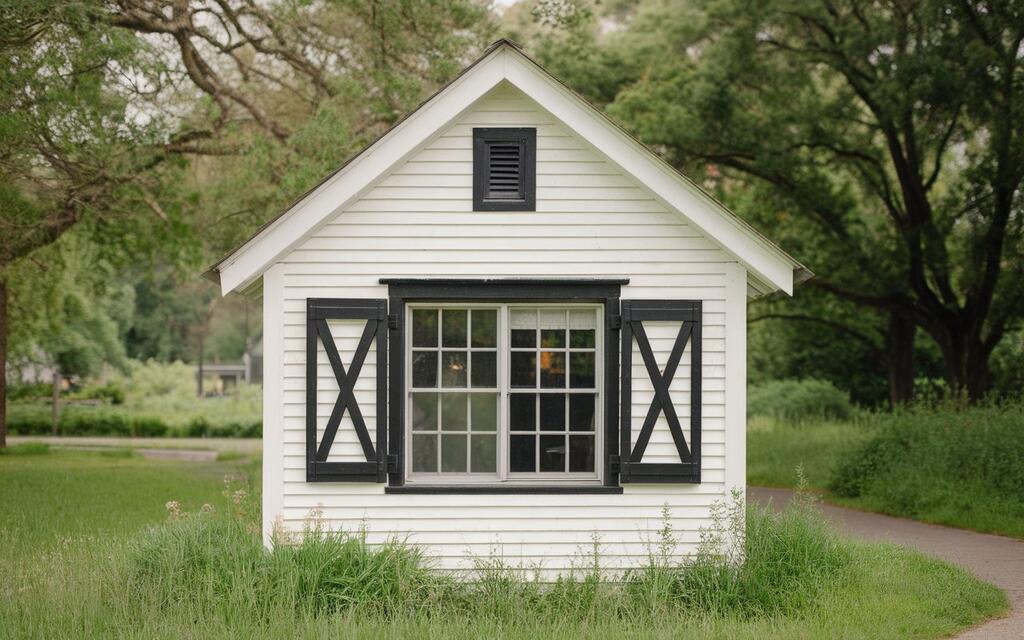
X-design shutters add character to your small white house instantly. They create a striking contrast against light walls. The X-pattern brings timeless farmhouse charm to any home style. Your windows gain depth and visual interest. These shutters make windows appear larger on compact facades. The dimensional design catches light beautifully throughout the day.
You need to choose properly sized shutters for balanced proportions. Too large overwhelms small houses. Too small looks insignificant. The right size creates harmony with your windows. Black X-shutters work particularly well with colonial, farmhouse, and cottage styles. They add sophistication without appearing too formal or stuffy.
Measure your windows first. Order custom shutters or modify ready-made options. Install them with proper hardware that supports their weight. Consider functional shutters that close for authentic appeal. Pairing these shutters with black door hardware or lighting fixtures creates a cohesive design language across your home’s exterior.
3. Wooden Front Door Accents
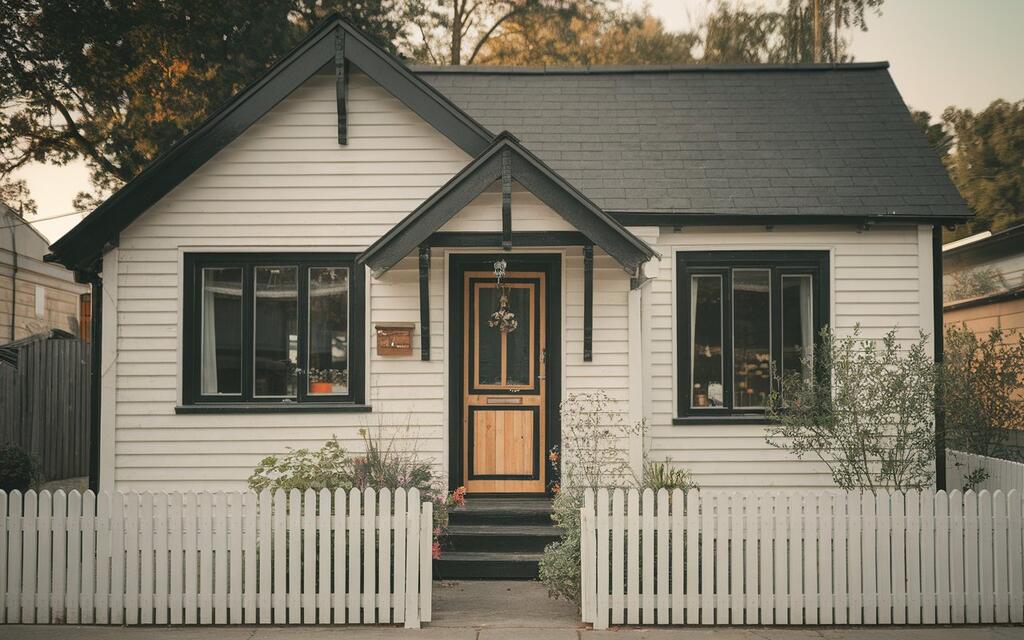
A wooden front door brings natural warmth to your black and white exterior. The rich tones create an inviting focal point. Wood adds texture against smooth painted surfaces. Your entryway becomes more welcoming instantly. This simple change softens the stark contrast of black and white. Natural materials add depth without complicating your color scheme.
Medium to dark wood stains work best with black trim. Walnut, mahogany, and dark oak complement black hardware beautifully. Honey or amber tones create a more casual, rustic feel. Cedar and cypress offer natural resistance to weather. The wood grain itself adds subtle pattern and visual interest. Black hinges and door handles complete this coordinated look.
Just replace your existing door or refinish it with quality wood stain. Remove paint from an existing wood door with proper stripping tools. Apply multiple thin coats of stain rather than one thick layer. Seal with exterior-grade polyurethane for lasting protection. Black trim around the door frame enhances the design connection.
4. Colorful Statement Doors
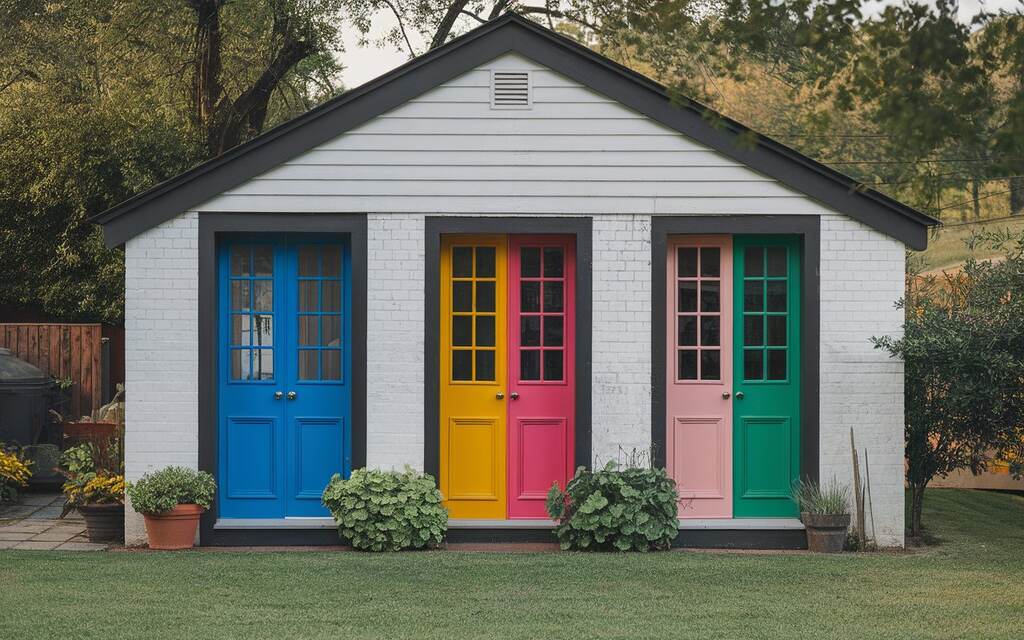
A vivid front door transforms your black and white house into a standout home. It creates a welcoming focal point that visitors notice immediately. Your entrance becomes the jewelry of your facade. Bold color shows personality without overwhelming. This small change makes a huge impact on curb appeal. The contrast draws the eye exactly where you want attention.
Several colors work beautifully with white houses and black trim. Classic red doors offer traditional charm with modern energy. Navy creates sophistication while maintaining the color scheme. Teal and turquoise bring coastal vibes to any location. Yellow doors radiate cheerful warmth year-round. Forest green connects with nature while still feeling polished.
To incorporate this feature, start with proper preparation. Clean and prime your door for the best color payoff. Choose exterior paint specifically formulated for doors. Apply several thin coats rather than one thick layer. Consider your home’s surroundings when selecting your color. Match flower beds or landscape elements for a cohesive look. Coordinate hardware in matte black to maintain connection with trim elements.
5. Black-Framed Glass Doors
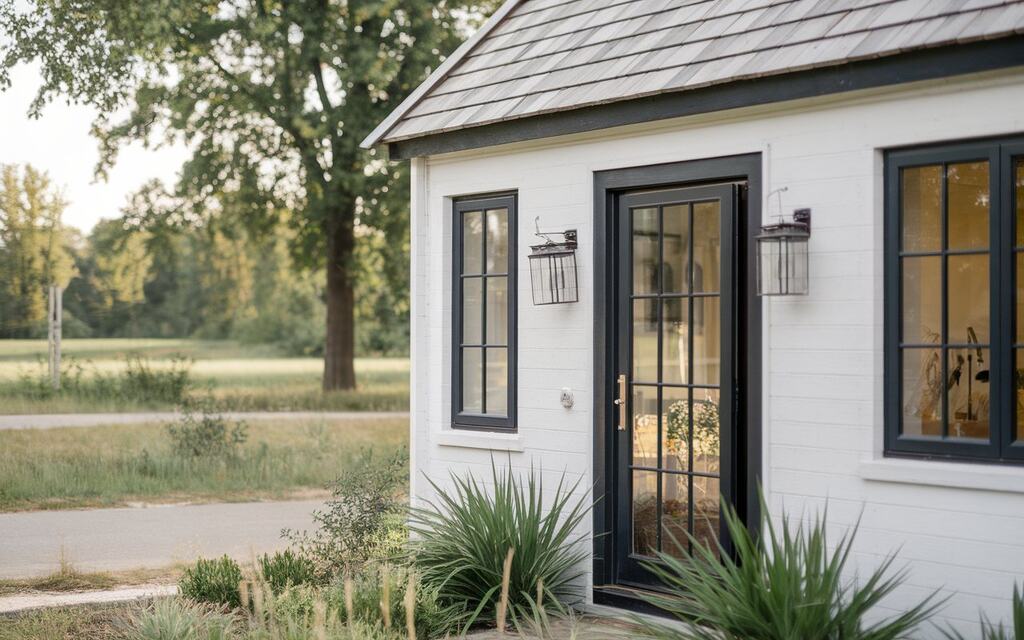
Black-framed glass doors transform small white houses with dramatic elegance. They flood interior spaces with natural light. Your rooms instantly feel larger and more open. The slim black frames create architectural interest without bulk. Glass panels maintain sight lines throughout compact spaces. The contrast between black frames and white walls creates definition and depth.
These doors seamlessly connect indoor and outdoor living areas. They frame garden views like living artwork. Your patio becomes an extension of your interior space. The black frames coordinate perfectly with your home’s trim. Modern or traditional glass door styles both work beautifully. French doors, sliding doors, or folding systems all enhance this design approach.
Start by measuring your existing door opening carefully. Consider how the door will swing or slide in your space. Install proper weatherstripping for energy efficiency. Choose tempered or double-paned glass for safety and insulation. Extend the black accent theme with outdoor furniture featuring black metal frames. Add black outdoor lighting fixtures and planters for visual continuity.
6. White Painted Brick with Black Accents
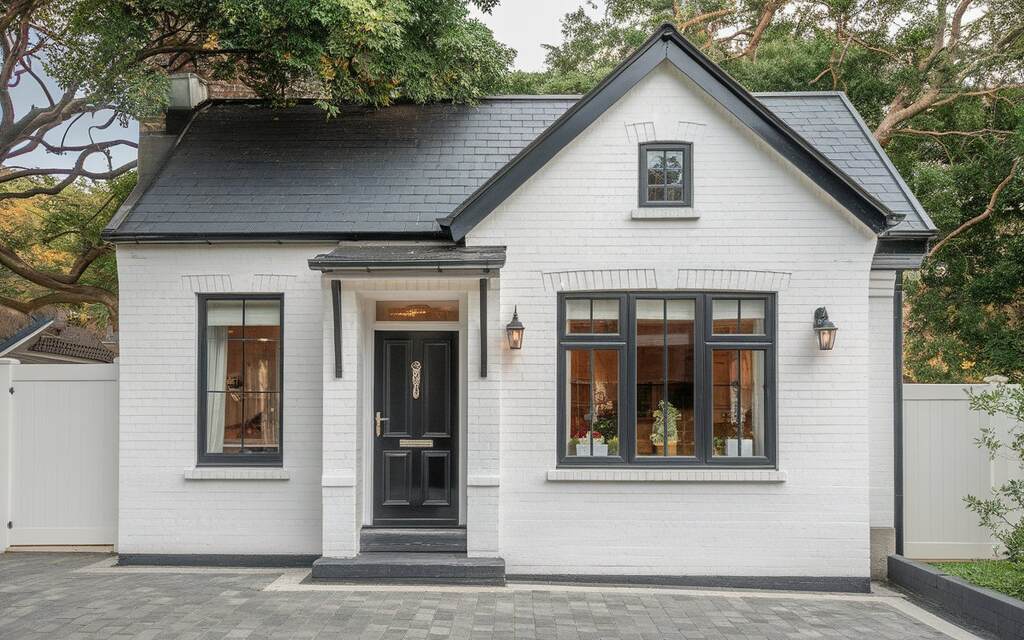
White painted brick creates magical transformations for outdated homes. The texture of brick remains visible beneath clean white paint. Your house maintains character while gaining modern appeal. Small brick homes appear larger when painted white. The monochromatic backdrop makes black accents stand out dramatically. Sunlight plays beautifully across the textured surface throughout the day.
Strategic black trim placement enhances architectural features on painted brick. Focus on black accents on window frames, door casings, and roof edges. Your gutters and downspouts become design elements when painted black. Black hardware on doors and windows creates cohesion. The contrast highlights the unique texture patterns in your brickwork. This combination works for cottages, ranches, and traditional brick homes alike.
Start with thorough brick cleaning and repair. Apply specialized masonry primer before painting. Choose exterior paint specifically formulated for brick surfaces. Consider leaving small brick details unpainted for added dimension. Install black metal house numbers, light fixtures, and mailbox for cohesive accent points. Add black planters with greenery to enhance your entryway. Maintain the crisp look with regular gentle cleaning of both white and black surfaces.
7. Vertical Board and Batten Siding
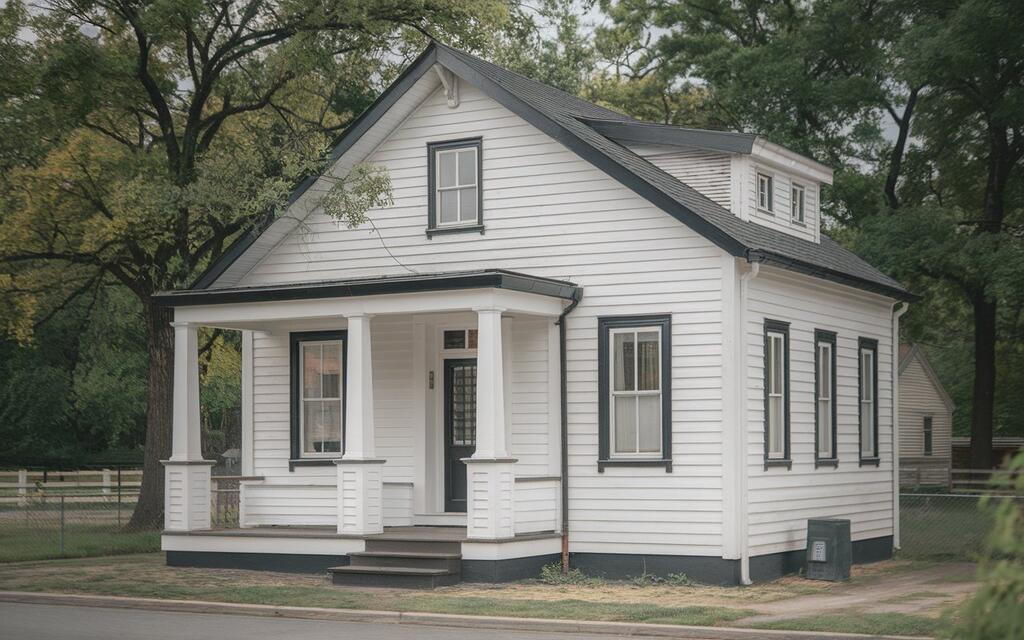
Vertical board and batten siding visually stretches your small home upward. The clean lines draw the eye from foundation to roofline. Your house appears taller and more substantial. This architectural trick works especially well on compact cottages and bungalows. White painted boards keep the look bright and airy. The subtle shadow lines add depth without overwhelming small facades.
Black trim creates striking definition against vertical white siding. Place black accents at transition points like corners and rooflines. Your windows pop dramatically when framed in black against vertical white. The contrast emphasizes the clean geometric patterns. Full-height installations maximize the heightening effect. This combination brings modern farmhouse appeal to even the smallest homes.
You can consider both full siding replacement and partial accent walls. Install boards with consistent spacing for the most pleasing effect. Use exterior-grade wood or fiber cement for durability. Apply multiple coats of quality white paint with proper primer. Focus black trim on architectural transition points and openings. Add black light fixtures and hardware that echo the linear pattern.
8. Black Porch Floors and Steps
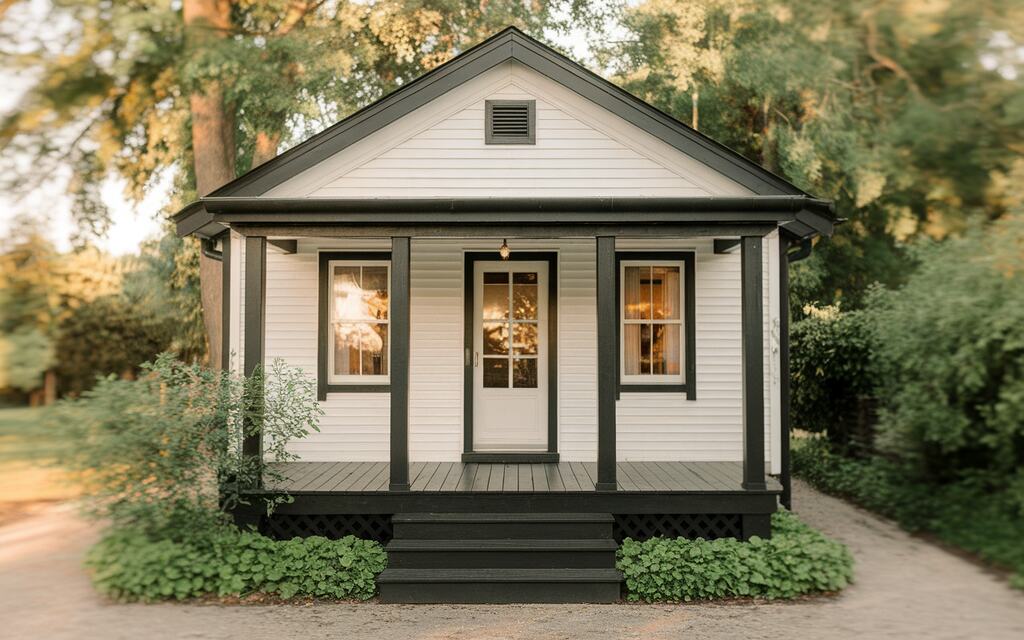
Black porch floors and steps create dramatic grounding for white houses. They frame your entrance with sophisticated contrast. Your porch gains visual weight and importance. The dark base makes white columns and railings stand out crisply. Black flooring hides dirt and footprints between cleanings. This practical choice doubles as a design statement. Small porches gain presence through this simple color application.
The dark base sets a perfect backdrop for decorative elements. Your colorful planters pop against the black surface. Neutral furniture looks intentional and designed. Outdoor rugs and pillows stand out more vividly. The black floor creates a visual boundary that defines your entrance zone. This color strategy makes modest entry areas feel more substantial and welcoming. The high-contrast look works across farmhouse, colonial, and contemporary styles.
To incorporate this design element, thoroughly clean and prepare your existing porch surface. Use exterior floor paint specifically formulated for foot traffic. Apply multiple thin coats rather than one thick layer. Consider black-stained wood as an alternative to paint for a natural texture. Extend the black finish to steps, risers, and porch edges for cohesion. Add white railing details to reinforce your color scheme. Incorporate black door hardware and light fixtures to connect the floor to your other black trim elements.
9. Black Pergolas and Fencing
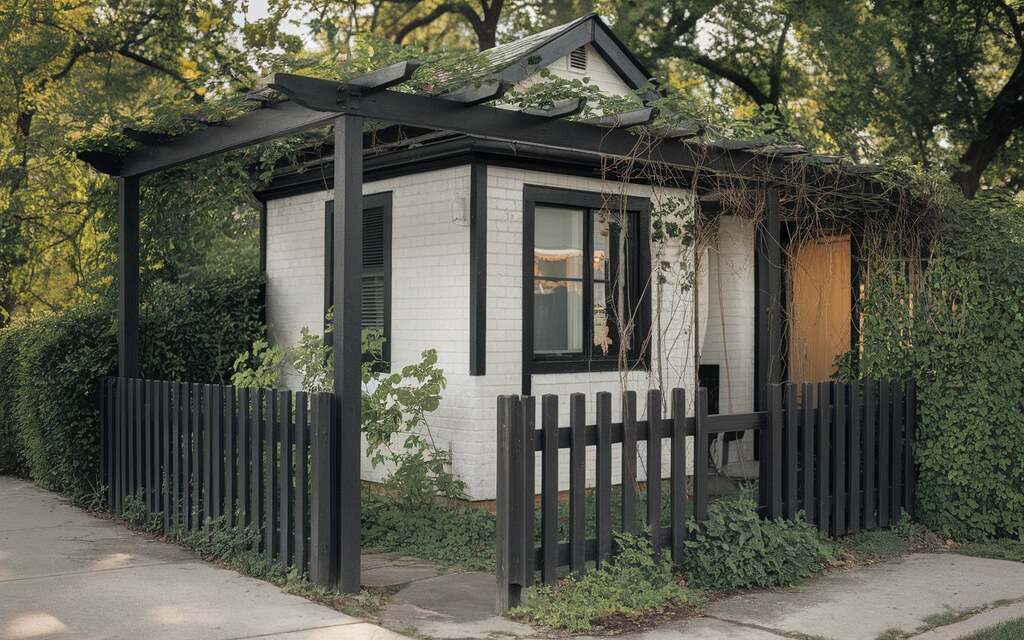
Black pergolas and fencing extend your home’s style into the surrounding landscape. The dark structures provide dramatic backdrops for plants to shine against. Black metal or painted wood elements add sophisticated boundaries. They define your property while maintaining a visual connection to your home’s aesthetic.
Your garden becomes an extension of your living space. The overhead beams cast interesting shadow patterns across white walls or patios. Black fencing establishes property lines with designer appeal. The vertical elements echo the window and door trim for cohesive design language. Small yards gain definition and purpose through these structured elements.
You can install a pergola near your house to create a transitional space between indoors and the garden. Position fencing to frame views rather than block them. Add climbing plants like roses or clematis on black structures for a stunning contrast. Place white outdoor furniture beneath pergolas to reinforce your color scheme. Install subtle lighting on pergolas and fence posts to extend enjoyment into evening hours.
10. Arched Windows and Doorways
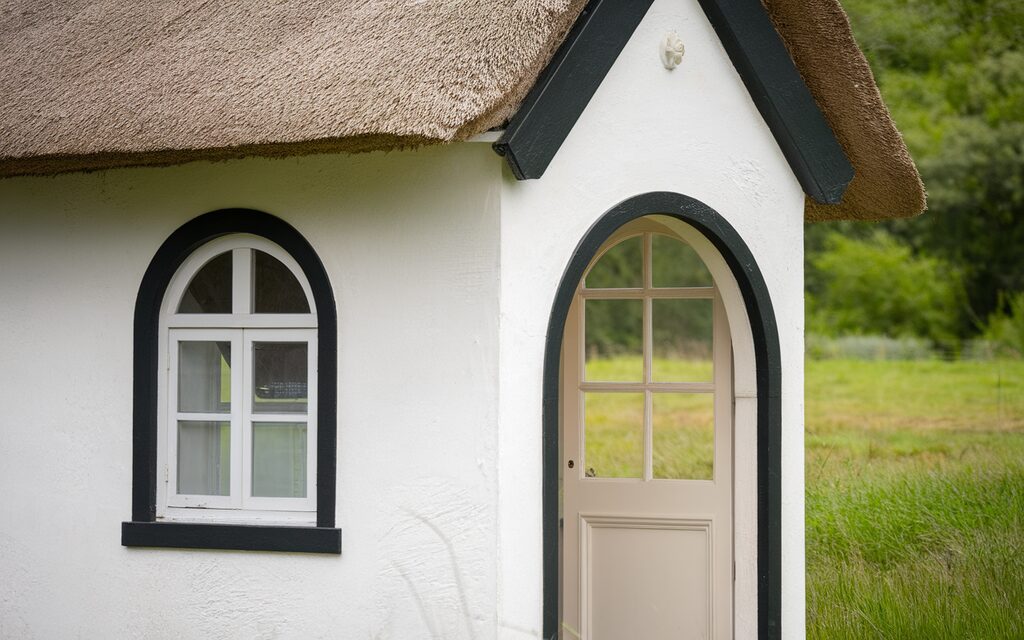
Arched windows and doorways add instant character to small white houses. Black trim around these curves creates stunning focal points. Your home gains European cottage charm or Spanish revival flair. The gentle curves soften the otherwise strict geometry of black and white. Arches draw the eye upward, making ceilings feel higher. They create natural frames for views both inside and out. Small spaces gain architectural interest without sacrificing simplicity.
These curved elements bring balance to the strong contrast of black against white. The flowing lines feel more organic and welcoming. Your entryway becomes more inviting with an arched door. Interior archways create graceful transitions between rooms. Black-trimmed arches define spaces without blocking light or sight lines. This design element works in cottage, Mediterranean, and modern minimalist styles alike.
You can add arched molding to square windows for an affordable update. Install arched doorways during renovations to maximize impact. Frame existing arches with black trim to highlight their elegant curves. Use arched mirrors on white walls to echo architectural elements. Place furniture to emphasize rather than block arched features. Extend the theme with rounded planters and curved outdoor seating elements.
11. Modern Paneling with Clean Lines
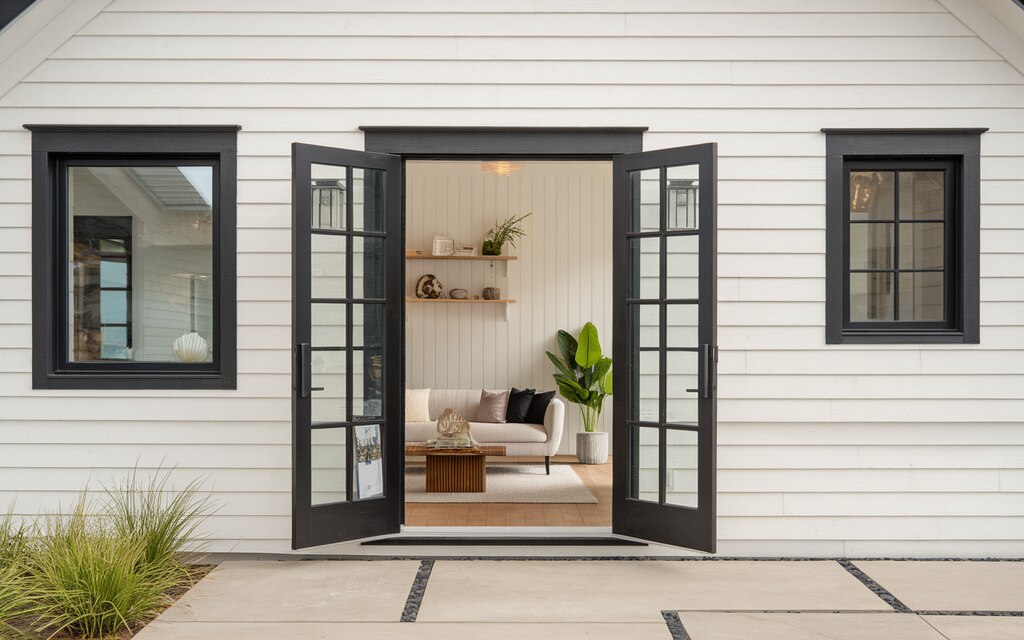
Smooth fiber cement panels transform small houses into contemporary showpieces. The crisp white surfaces create perfect backdrops for geometric black trim. These panels resist warping and rotting unlike wood alternatives. The clean lines complement minimal landscapes. Each panel creates subtle shadow lines that add dimension. Installation patterns can emphasize either vertical or horizontal movement.
Black trim creates striking geometric patterns against white modern panels. The high-contrast framework turns your home exterior into an artistic statement. Your windows and doors become integrated design elements rather than interruptions. Thin black trim provides subtle definition. Thicker black borders create bold graphic impact. This approach works beautifully on mid-century modern, contemporary, and minimalist home styles.
To incorporate this design, select fiber cement panels in smooth rather than textured finishes. Install them in a regular grid pattern for classic appeal or staggered for modern asymmetry. Use specialized exterior-grade black trim pieces designed for panel systems. Focus on black accents on panel joints, windows, and rooflines. Add black hardware, house numbers, and lighting fixtures in simple geometric shapes.
12. Lush Greenery Contrast
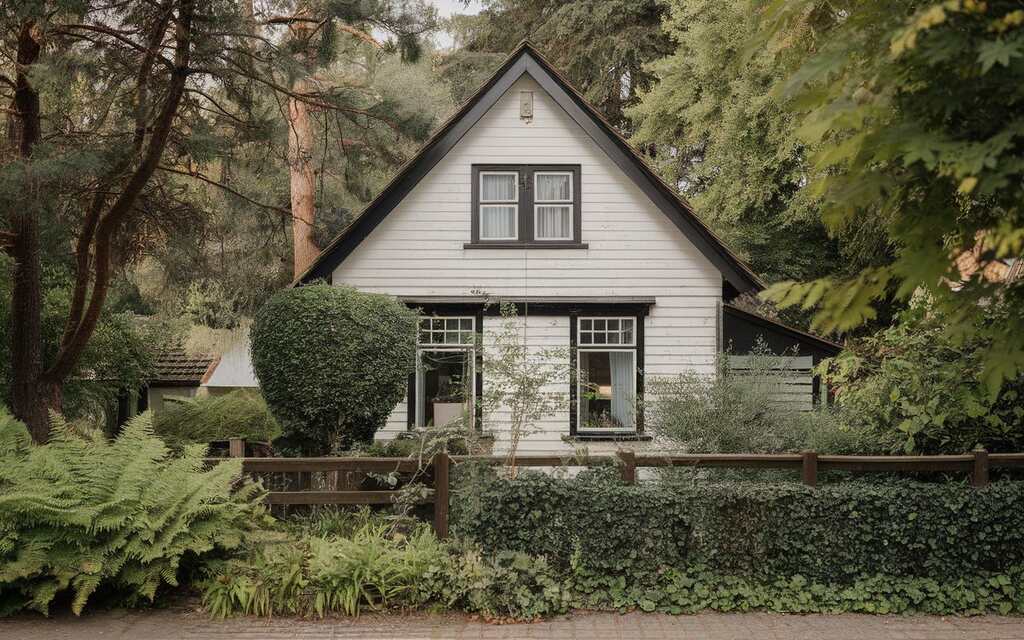
Lush greenery creates natural balance against stark black and white exteriors. The vibrant foliage softens hard architectural lines. Black trim frames the natural elements perfectly. Plants bring movement and seasonal change to static structures. Small houses benefit from this added layer of visual interest without sacrificing square footage.
Container gardens offer perfect solutions for limited spaces around small homes. Black planters coordinate with trim elements for design cohesion. Your porch, steps, and walkways transform with strategic plant placement. Climbing vines on black trellises create living walls. Window boxes with trailing plants soften window edges. Evergreen shrubs provide year-round structure while flowering plants add seasonal color.
To incorporate this design element, select plants suited to your climate and sun exposure. Group containers of various heights for maximum impact. Place tall planters at corners to define boundaries without fencing. Line walkways with matching containers for a formal approach. Use black metal or painted wood planters to reinforce your trim color.
Practical Tips for Small White Houses with Black Trim
- Keep black accents to 20-30% of your exterior. Focus on windows, doors, and rooflines. Test white shades at different times of day. Add black hardware and address numbers for cohesion without overwhelming your small space.
- Use fiber cement siding and composite trim for durability. Apply UV-protected exterior paint to prevent fading. Choose powder-coated metal for black elements in harsh climates. Clean white surfaces twice yearly to maintain crisp contrast.
- Make your entrance pop with bold black framing. Place black elements at varying heights to guide the eye across your facade. Mix textures like smooth white siding against textured black stone for dimension without bulk.
- Install black sconces that wash light up white walls. Add path lighting to extend your living space after dark. Place rotating seasonal blooms in black containers. Switch door wreaths quarterly to refresh your exterior cheaply.
- Plant vertical elements at property edges to draw eyes upward. Define garden beds with crisp black borders. Position matching planters along walkways for visual rhythm. Add a small water feature for movement in compact spaces.
Conclusion
White houses with black trim create timeless appeal for homes of any size. Start small by painting your front door or adding black shutters. Move to window casings or siding as your budget allows. This color scheme works across all architectural styles from farmhouse to modern. Begin today with a paint sample test on a single window. Quality materials reduce long-term maintenance costs. Your modest home will instantly gain presence through these strategic design choices.
FAQs
What is the best white paint for a small house exterior?
Soft whites like Benjamin Moore’s “White Dove” or Sherwin-Williams’ “Alabaster” work beautifully on small homes. They reflect light without harsh glare. Test samples on different sides of your house before committing. Consider your climate, warmer whites resist showing dirt in rainy regions.
How do I maintain a white house with black trim?
Clean white surfaces twice yearly with a gentle pressure washer. Touch up black trim annually to prevent fading. Trim plants away from siding to prevent mildew. Inspect caulking regularly. Apply a clear protective coating to extend the time between paint jobs.
Will a small white house with black trim make my house look bigger?
Yes! White visually expands walls while black trim creates definition and architectural interest. Use black strategically on windows and doors rather than randomly. Paint eaves white to visually raise your roofline. This high-contrast approach makes modest homes appear more substantial.
How can I add color to a small white house with black trim?
Introduce color through your front door, teal, red, or yellow, all pop beautifully. Add colorful planters with seasonal flowers. Include garden beds with perennials near your foundation. Colorful outdoor furniture and pillows create instant charm without permanent commitment.
Is a small white house with black trim more expensive to maintain?
Not significantly. White may show dirt sooner, requiring more frequent cleaning. Black absorbs heat, potentially causing faster fading in sunny climates. Offset these concerns with quality materials upfront. Modern paints with UV protection and proper preparation minimize long-term costs.

